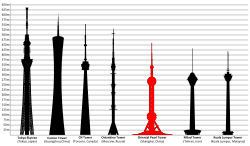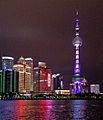Oriental Pearl Tower facts for kids
Quick facts for kids Oriental Pearl Radio & TV Tower |
|
|---|---|
|
东方明珠广播电视塔
|
|

The Oriental Pearl Tower in December 2014
|
|
| General information | |
| Type | Communication, hotel, observation, restaurant |
| Location | Shanghai |
| Coordinates | Lua error in Module:Coordinates at line 614: attempt to index field 'wikibase' (a nil value). |
| Construction started | July 30, 1991 |
| Completed | 1994 |
| Opened | 1995 |
| Height | |
| Antenna spire | 468 m (1,535 ft) |
| Top floor | 351 m (1,152 ft) |
| Technical details | |
| Floor count | Equivalent of a 103 story building |
| Lifts/elevators | 6 |
| Design and construction | |
| Architect | Shanghai Modern Architectural Design Co. Ltd. |
| Developer | Shanghai Oriental Group Co. Ltd. |
The Oriental Pearl Radio & Television Tower (simplified Chinese: 东方明珠电视塔; traditional Chinese: 東方明珠電視塔; pinyin: Dōngfāng Míngzhū diànshì tǎ; Shanghainese: Tonfån Mintsythah) is a TV tower in Shanghai. Its location at the tip of Lujiazui in the Pudong New Area by the side of Huangpu River, opposite The Bund, makes it a distinct landmark in the area. Its principal designers were Jiang Huan Chen, Lin Benlin, and Zhang Xiulin. Construction began on July 30, 1991, and the tower was completed on October 1, 1994, and put into use on May 1, 1995.
Contents
History
Planning
On August 25, 1983, the idea of building a new TV tower was first brought up in a broadcast considering the overwhelming situation of the existing TV transmission tower at that time. On November 17 of the same year, a clear thought of building a TV tower of approximately 400 metres (1,300 ft) high around Lujiazui area was presented in "The Sixth Five-Year Plan and Seventh Five-Year Plan for the Development of Shanghai's Radio and Television Industry and the Vision for the Next Ten Years."
On March 25, 1984, the proposal of building the new TV tower is officially made in the Congress report. Later in 1984, the proposal was approved. After repeated investigation and research, the site location was finalized to between Lujiazui and Pudong Park, with the consideration of echoing with the Bund on the other side of Huangpu River.
On August 23, 1984, the Shanghai Radio and Television Bureau officially made the site selection report. In October 1986, the report was finalized and submitted to the National Planning Commission, with the building height initially set at 450 metres (1,480 ft). In January 1987, the report was approved. In January 1988, the Shanghai Radio and Television Bureau submitted a feasibility report for the TV tower and got approved in July.
In May 1988, three top design institutes in China were invited to participate in a design contest for the TV tower. In September 1988, a total of 12 designs were submitted and evaluated, and the "Oriental Pearl" design from East China Architectural Design Institute was finally chosen. With the consideration of the location and historical role of the tower, the designer chose to connect 15 spheres of different sizes with pillars as the main tower body. The artistic conception came from the sentence "big and small pearls falling on a jade plate(大珠小珠落玉盘)" of a poem "Pi Pa Xing(琵琶行)" by Bai Juyi, intended to emphasize the oriental cultural atmosphere and the artistic sentiment of Shanghai.
Construction
On July 30, 1991, the foundation of the Oriental Pearl TV Tower was officially laid and the construction started.
On December 14, 1993, the 350 metres (1,100 ft) 3-D structure (excluding the antenna) was capped. The construction only took 27 months, which is 105 days prior to the expected date. At 12:12 a.m. on May 1, 1994, world's first steel antenna with a length of 110 metres (360 ft) and a weight of 450 metric tons (500 short tons) was successfully installed in position after 11 days of ascension.
On October 1, 1994, the ground floor lobby decoration was completed. The sightseeing facilities and main light system started operating. The construction of Oriental Pearl TV Tower was officially completed.
20th century
On May 1, 1995, the ribbon cutting ceremony of the Oriental Pearl TV Tower was held and it is officially opened to the public. The first signal was launched, and it first broadcast 5 sets of TV programs and 5 sets of FM radios to the public.
In 1995, 15 foreign heads of government visited the tower. At the end of the year, the Oriental Pearl TV Tower was rated as one of the Top Ten New Landscapes in Shanghai.
In 1996, another 35 foreign heads of government and 30 groups of foreign minister-level government officials visited the tower.
In 1999, the Oriental Pearl TV Tower won the first prize of Shanghai Excellence of Design Award and China Civil Engineering Zhan Tianyou Award.
21st century
In May 2001, the Shanghai Urban History Development Exhibition Hall was opened at ground level of the Oriental Pearl TV Tower.
In 2004, the tower carried out an energy-saving transformation on the light system, replacing the old source with light-emitting diodes.
On May 8, 2007, the Oriental Pearl TV Tower was approved by the National Tourism Administration as a National AAAAA-level Tourist Attraction.
On January 6, 2020, the Oriental Pearl TV Tower was rated as one of the Top Ten New Landmarks in Shanghai by the China Architectural Culture Research Association.
Observation levels
The tower has fifteen observatory levels. The highest (known as the Space Module) is at 351 metres (1,150 ft). The lower levels are at 263 metres (863 ft) (Sightseeing Floor) and at 90 metres (300 ft) (Space City). There is a revolving restaurant at the 267 metres (876 ft) level. The project also contains exhibition facilities and a small shopping center. There is also a 20-room hotel called the Space Hotel between the two large spheres. The upper observation platform has an outside area with a 1.5 inches (3.8 cm) glass floor.
Gallery

See also
 In Spanish: Torre Perla Oriental para niños
In Spanish: Torre Perla Oriental para niños





